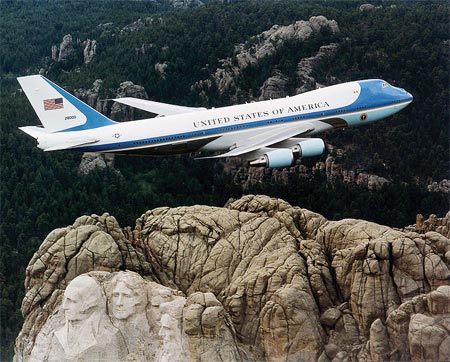 Unfortunately, one of the realities of flying at altitude over famous landmarks is that they just don't quite have the same impact as from the ground. The air traffic controller that was vectoring us around to the airport (I think) was kind enough to bring us close to a very famous location. Unfortunately, he brought us right over the top of this site, Mt Rushmore, so we were unable to see any of it. The picture on the left is obviously not what I fly, and it appears to have been photoshopped. The perspective just doesn't make sense! Check out the official website at http://www.nps.gov/moru/index.htm
Unfortunately, one of the realities of flying at altitude over famous landmarks is that they just don't quite have the same impact as from the ground. The air traffic controller that was vectoring us around to the airport (I think) was kind enough to bring us close to a very famous location. Unfortunately, he brought us right over the top of this site, Mt Rushmore, so we were unable to see any of it. The picture on the left is obviously not what I fly, and it appears to have been photoshopped. The perspective just doesn't make sense! Check out the official website at http://www.nps.gov/moru/index.htmAnyway, after we finished our scenic tour it was time to make our long anticipated approach into Rapid City. The reason there was some anticipation was because of this METAR: KRAP 021952Z 32035G42KT 10SM CLR 12/M06 A2988 RMK AO2 PK WND 33048/1926 Translated, this means on October 2nd at 1952Z(Zulu) the winds were out of the northwest (320 degrees) at 35knots, gusting to 42kts. Later in the weather report it says, PK WND (peak wind) 48kts at 1926Z. As a comparison here is a conversion for the equivalent miles per hour:
| | | | | |
| | | | | |
| | | | | |
| | | | | |
What does that really mean? Well, according to the Beaufort Scale:
| 32 - 38 | Moderate gale whole trees in motion; inconvenience in walking against wind |
| 39 - 46 | Fresh gale breaks twigs off trees; generally impedes progress |
| 47 - 54 | Strong gale slight structural damage occurs; chimney pots and slates removed |
So the captain and I discussed the weather before we left Idaho. Although I've been flying the X for a year and a half, the CPT has been flying it for seven. He gave me the option of flying the leg, but we figured that the gusty winds could cause some difficulties as far as the landing would go. It's not that we didn't think I could handle it, but IF something were to happen, it'd be pretty awkward trying to explain why we didn't have the more experienced crewmember on the controls. Especially with all of the bad press the aviation industry is getting lately.
Luckily the winds were right down the runway and turned out to not be an issue. It was kind of funny seeing less than 100kts of groundspeed in a X, and seeing traffic on the highway below almost matching our speed! Once we landed, we had more of a battle packing up the airplane and getting into the van without being blown over! In the van a fellow passenger (not a pilot) asked us if we had to learn to land faster in such high winds. Actually, we explained, that airplanes land INTO the wind, so actually we were landing more slowly. Our low ground speed was our airspeed (about 130kts) - the wind speed (30kts) = 100kts. The airplane doesn't fly in relation to the speed over the ground, however, but the relative speed with which is moving through the air.
 From the van I took this picture of a helicopter whose blades were just going crazy with the wind blowing. This is a Sikorsky 58T, a military helicopter originally designed for service in the anti-submarine warfare (ASW) role. It is now often used in construction, like Desiree does and blogs about in The Adventures of Chopper Chick! Not also does Desiree support Girls With Wings but she has also received great publicity for all of the amazing things she's done flying helicopters in many different capacities. p.s. I also love that "Chopper" also refers to her having a motorcycle, which I do as well!
From the van I took this picture of a helicopter whose blades were just going crazy with the wind blowing. This is a Sikorsky 58T, a military helicopter originally designed for service in the anti-submarine warfare (ASW) role. It is now often used in construction, like Desiree does and blogs about in The Adventures of Chopper Chick! Not also does Desiree support Girls With Wings but she has also received great publicity for all of the amazing things she's done flying helicopters in many different capacities. p.s. I also love that "Chopper" also refers to her having a motorcycle, which I do as well!
Hope to be a Chopper Chick one day. ;) Excellent story.
ReplyDeleteAlzira
Great story! I've flown into Rapid City a couple of times, always on long cross country trips with a client is a Cirrus SR22 or Cessna 400. Each time we ask to be vectored over Mt. Rushmore and each time we're a little disappointed by the view. It's always later in the day when we arrive, so perhaps the sun angle has something to do with it. I can't wait to visit it from the ground someday.
ReplyDelete